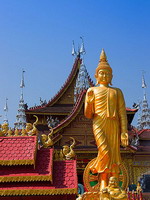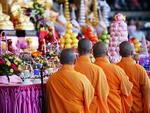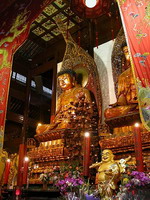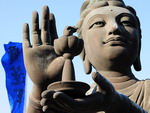The Genesis and Spread of Buddhism
 There exist a lot of stories and legends how Buddhism has found the way to China. The most common of them is a legend of the White Horse. It tells that the first Buddhistic scriptures were brought to Luoyang city on a white horse, this fact caused the Baima-si or White Horse Temple, the first Buddhist temple in China, to be founded.
There exist a lot of stories and legends how Buddhism has found the way to China. The most common of them is a legend of the White Horse. It tells that the first Buddhistic scriptures were brought to Luoyang city on a white horse, this fact caused the Baima-si or White Horse Temple, the first Buddhist temple in China, to be founded.
The history of Buddhism in China is closely intertwined with the history of the Silk Road. Beginning from the first century BC, Buddhist monks were accompanying the caravans travelling from India to western China. Thus, Buddhism began penetrating deep into China and the Far East.
A huge impact on the development of Buddhism in China was also exerted by the merchants from Central Asia, in whose territory Buddhism was the state religion during the period of the Kushan Empire. By the III century Buddhism became the dominant religion in East Turkestan (Xinjiang).
 This period saw an active construction of Buddhistic temples and monasteries, especially in the territory of East Turkestan. The so-called cave monasteries, which were just a chain of cut-in-rock small caves-cells, decorated with frescoes and paintings on Buddhistic themes, were widely spread at that time.
This period saw an active construction of Buddhistic temples and monasteries, especially in the territory of East Turkestan. The so-called cave monasteries, which were just a chain of cut-in-rock small caves-cells, decorated with frescoes and paintings on Buddhistic themes, were widely spread at that time.
Among these temples the most famous are the Mogao Grottoes (Dunhuang) and Kyzyl caves (Kuchar). The largest cells and places of worship are of size of small temples while statues of Buddha are as high as 17 meters.
Fundamentals of Buddhist Philosophy
 At the basis of Buddhist philosophy is the theory that people are to blame themselves for their misfortunes and sufferings. However, to do away with the suffering is possible through self-restraint and achievement of nirvana. One of the main Buddhist rules is the attainment of enlightenment based on own experience.
At the basis of Buddhist philosophy is the theory that people are to blame themselves for their misfortunes and sufferings. However, to do away with the suffering is possible through self-restraint and achievement of nirvana. One of the main Buddhist rules is the attainment of enlightenment based on own experience.
The basis of this Buddhist rule gave rise to formation of several schools of thought. Some of them based their of Buddhist philosophy on an adoration to Buddha and ritual ceremonies, while others believed that enlightenment can be achieved through meditation and performing good deeds. However, all of them relied on the “Four Noble Truths” and “Eightfold Path”, the first Buddha’s sermons, underlying in all his 84,000 sermons.
The Four Noble Truths are suffering and the causes of this suffering. The ways to stop the causes of suffering are given in the Eightfold Path canons; the cessation of suffering in Buddhism is called Nirvana. In addition, the differences between the Buddhist schools also depend on the way they follow in their enlightenment: “Mahayana” - a large chariot or “Hinayana” - a small chariot. The Mahayana followers believe that the enlightenment can be reached by everybody. In contrast, the Hinayana followers focus on a personal enlightenment.
Features of Buddhist Worship in China
 The most widespread Buddhist cult in China up to date is the cult of Amitabha Buddha (the Sanskrit word “Amitabha " means boundless light), formed by the monk Huainan, one of the founders of Buddhist philosophy in China. Amitabha, one of the five Buddhas of Wisdom, is believed was a ruler, but having got enlightened abdicated and became a monk. Amitabha is often compared with Mithra, Zoroastrian god of light and sun, which is quite symbolic, since Amitabha in Buddhism personifies the light in the literal and figurative sense.
The most widespread Buddhist cult in China up to date is the cult of Amitabha Buddha (the Sanskrit word “Amitabha " means boundless light), formed by the monk Huainan, one of the founders of Buddhist philosophy in China. Amitabha, one of the five Buddhas of Wisdom, is believed was a ruler, but having got enlightened abdicated and became a monk. Amitabha is often compared with Mithra, Zoroastrian god of light and sun, which is quite symbolic, since Amitabha in Buddhism personifies the light in the literal and figurative sense.
Cult of Amitabha is the most numerous and widespread, not only in China, but also all over Southeast Asia. The Buddhists believe that this deity helps in regeneration and improvement. The figure of Amitabha, in one way or another, is reflected almost in all the frescoes of Buddhist cave temples of Xinjiang.
Buddhism in China has its own characteristic features. In many extant Xinjiang cave temples it is still possible to see murals, reflecting, in the light of Buddhist philosophy, other ancient religions of that region: the Taoism, Manichaeism and Zoroastrianism, so the Chinese Buddhism in contrast to the traditional one, is rather an embodiment of several religions in one.

